- Barajar
ActivarDesactivar
- Alphabetizar
ActivarDesactivar
- Frente Primero
ActivarDesactivar
- Ambos lados
ActivarDesactivar
- Leer
ActivarDesactivar
Leyendo...
Cómo estudiar sus tarjetas
Teclas de Derecha/Izquierda: Navegar entre tarjetas.tecla derechatecla izquierda
Teclas Arriba/Abajo: Colvea la carta entre frente y dorso.tecla abajotecla arriba
Tecla H: Muestra pista (3er lado).tecla h
Tecla N: Lea el texto en voz.tecla n
![]()
Boton play
![]()
Boton play
![]()
19 Cartas en este set
- Frente
- Atrás
- 3er lado (pista)
|
Processes of communication models
|
1. Linear models: person - person. Receiver is affected by a message from a source in progressive linear steps.
2. Interactive model: communication as interactive process by formulating, exchanging, interpreting a message. 3. Transactional model: assumes that people are connected through communication and are sender and receiver simultaneously. |
3
|
|
Goals of mass communication
|
1. Explain effects of mass comm.
2. Explain uses of mass comm. 3. Explain how people learn from mass media. 4. Explain media's role in shaping people's values and views. Influence. |
4 explain
|
|
Why is a theory useful?
|
Theory is the ultimate goal of science. The goal of a theory is to formulate statements or propositions with explanatory power.
|
Science, explanatory power
|
|
Effects of communication
|
- agenda setting
- priming/framing - cultivation 1. Individual effects. Microanalytical model: - com stock psychological model: describes certain mental processes while watching tv. - Thorson's cognitive processing model: concentrates on processing of TV comercials. 2. Social effects: macro analytical model. Media dependency model. Media should be studied in the context of larger social systems. The more a person depends on media to meet needs the more important media will be in a person's life. |
|
|
Difference between a theory and a model?
|
A theory is fixed and it cannot be changed. It is a statement with explanatory power that is proved.
A model it is a frame where we discuss and that can be modified and it can even fail. They organizes concepts and complex meaning. It is a kind of theory in development. |
|
|
Fisher's model
Small group comm. |
Decision making process in a small group.
1. Orientation step: get to know each other . Feeling uncomfortable because of lack of communication. 2. Conflict phase: each person propose a solution and discuss. Difference of opinions and leaders rises up. 3. Emergence phase: people try to come up with solutions. Group's task and arrangement become noticeable. 4. Reinforcement: agreement in one solution, but some people don't get to be represented. |
4
|
|
Duck's filtering model
|
People consider different cues or filters and the nodes that pass through them end up in relationships.
1. Incidental cues: do to where live or work, or any circumstance. 2. Pre-interaction cues: information that you have about a person before you talk. 3. Interactive cues: interaction helps to evaluate if to include or explore somebody. 4. Cognitive cues: evaluation on the basis of the character. Share some interest, we would sustain a relationship. |
4
IPIG |
|
Helical model
|
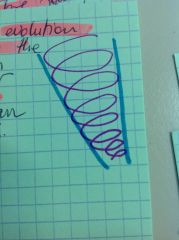
Model that explains the evolution of the communication skills in the life of a person.
Critic: when you grow older your communication skills reduce. So it wouldn't be an infinite helical process. |
|
|
Helical model
|
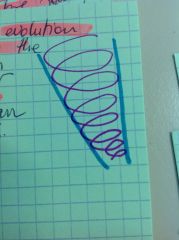
Model that explains the evolution of the communication skills in the life of a person.
Critic: when you grow older your communication skills reduce. So it wouldn't be an infinite helical process. |
|
|
People's model
Small group communication |
Consists of various tracks used for interpreting the communication styles that a group follows. Tracks can repeat or happen in any order.
1. Task track: understanding period to try figure out its procedure. 2. Relation track: interaction with members of the group. 3. Topic track: discuss takes place. Argumentative or cooperative conversation. 4. Break points: shifts from one track to the other. |
|
|
Aida model
|
A ttention of the consumer
I nterest of the consumer D esire. Convince customer about a product A tion. Consumer buys a product It is a marketing and advertising model. |
|
|
Harold Dwight Lasswell chain of communication
|
Who says- control
What - content In which channel - media To whom - audience With what effect - effect There is no feedback. Classical model criticized because gets only one way of communication and doesn't considers feedback. But was the first to consider that the audience could choose the channel and pick up the information. |
WWITW
|
|
Pierce model
|
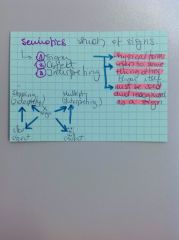
1. Sign: it has a physical form, refers to something other than the itself and must be recognized as a sign.
2. Object 3. Interpreting |
Semiotics
|
|
Maletzke model
|
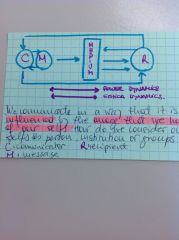
We communicate in a way that it is influenced by the image that we have of our selfs. How do we consider our selfs as persons, institutions or groups.
C: communicator M: message R: recipient |
|
|
Johari Window model
|
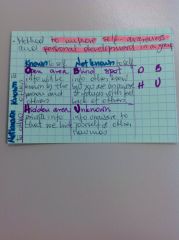
Method to improve self awareness and personal development in a group
|
|
|
Shannon-Weaver's model
|
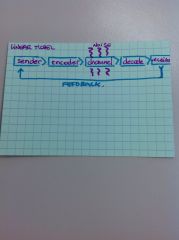
|
|
|
Schramm interactive model
|

|
|
|
Westley Mac Lean model
|

|
|
|
Grabbers model
|
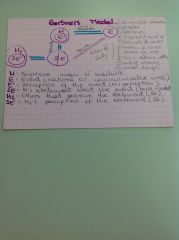
- grabber was interested in the perception and production dimension
- also in the social implications for the role of the state in a democratic society in terms of the tension between freedom and control. - the statements we produce depend of the channels or media accessible to us and the restrictions and controls placed in the access - regulation (on the vertical axis) is needed to prevent censorship - tension freedom-control: self government in a democratic society requires that citizens are able to freely select, discuss and express. - government's duty is to promote selection and availability of information. CRITICS: - another linear transmission model. Although gebner shows this model as interactive and dynamic because M is source and transmitter. - limit: no distinction between witnessing and mediated representation |